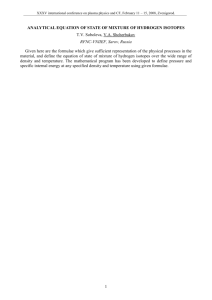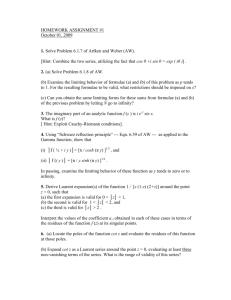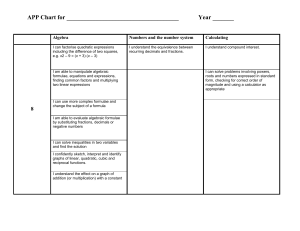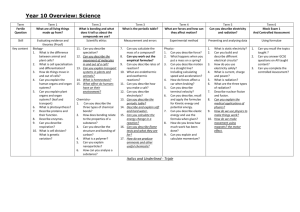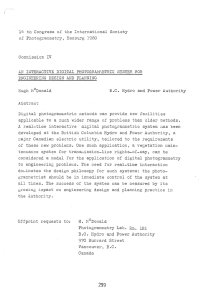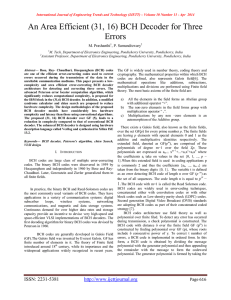Notes on Baker-Campbell-Hausdorff (BCH) Formulae
advertisement
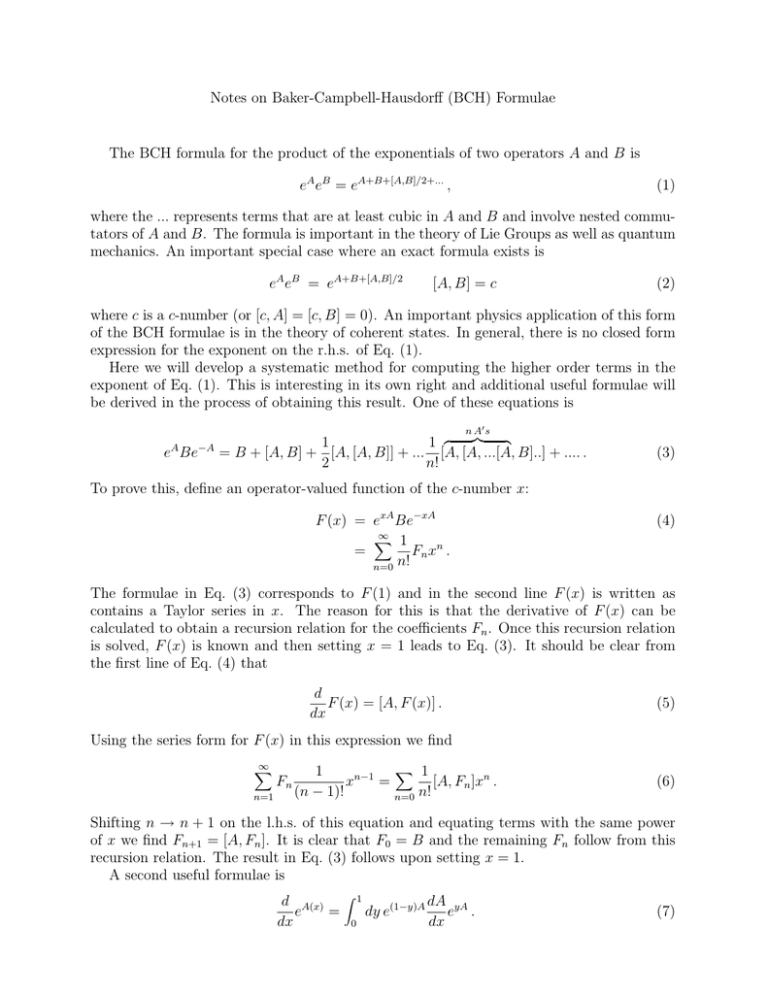
Notes on Baker-Campbell-Hausdorff (BCH) Formulae
The BCH formula for the product of the exponentials of two operators A and B is
eA eB = eA+B+[A,B]/2+... ,
(1)
where the ... represents terms that are at least cubic in A and B and involve nested commutators of A and B. The formula is important in the theory of Lie Groups as well as quantum
mechanics. An important special case where an exact formula exists is
eA eB = eA+B+[A,B]/2
[A, B] = c
(2)
where c is a c-number (or [c, A] = [c, B] = 0). An important physics application of this form
of the BCH formulae is in the theory of coherent states. In general, there is no closed form
expression for the exponent on the r.h.s. of Eq. (1).
Here we will develop a systematic method for computing the higher order terms in the
exponent of Eq. (1). This is interesting in its own right and additional useful formulae will
be derived in the process of obtaining this result. One of these equations is
n A0 s
}|
{
1
1
eA Be−A = B + [A, B] + [A, [A, B]] + ... [A, [A, ...[A, B]..] + .... .
2
n!
z
(3)
To prove this, define an operator-valued function of the c-number x:
F (x) = exA Be−xA
∞
X
1
=
Fn x n .
n!
n=0
The formulae in Eq. (3) corresponds to F (1)
contains a Taylor series in x. The reason for
calculated to obtain a recursion relation for the
is solved, F (x) is known and then setting x =
the first line of Eq. (4) that
(4)
and in the second line F (x) is written as
this is that the derivative of F (x) can be
coefficients Fn . Once this recursion relation
1 leads to Eq. (3). It should be clear from
d
F (x) = [A, F (x)] .
dx
(5)
Using the series form for F (x) in this expression we find
∞
X
n=1
Fn
X 1
1
xn−1 =
[A, Fn ]xn .
(n − 1)!
n!
n=0
(6)
Shifting n → n + 1 on the l.h.s. of this equation and equating terms with the same power
of x we find Fn+1 = [A, Fn ]. It is clear that F0 = B and the remaining Fn follow from this
recursion relation. The result in Eq. (3) follows upon setting x = 1.
A second useful formulae is
d A(x) Z 1
dA
e
=
dy e(1−y)A eyA .
dx
dx
0
(7)
Here A(x) is an arbitrary function of x. To see why Eq. (7) is true both sides must be
expanded in a power series in A and A0 = dA/dx. On the l.h.s. we find
d A(x)
d
1
1
e
=
1 + A + A2 + A3 + ...
dx
dx
2
3!
0
0
A A + AA
A0 A2 + AA0 A + A2 A0
0
= A +
+
+ ... .
2
3!
(8)
The key point is that when we differentiate An we cannot assume that A and A0 commute
so we get n terms with n − 1 A’s and one A0 with all possible orderings of these n factors.
This series can written as
∞ X
∞
X
1
An A0 Am
(n
+
m
+
1)!
n=0 m=0
(9)
However this is the series generated by the integral in Eq. (7). Expanding both exponentials
one finds
Z 1
(1−y)A dA yA
dy e
dx
0
e
∞ X
∞
X
An A0 Am Z 1
=
dy(1 − y)n y m
n!m!
0
n=0 m=0
∞
∞ X
X
1
An A0 Am ,
=
n=0 m=0 (n + m + 1)!
(10)
where the last line follows from the integral
Z 1
dy(1 − y)n y m =
0
n!m!
.
(n + m + 1)!
(11)
Finally multiply Eq. (7) by e−A to obtain
e−A
Z 1
dA
d A
dy e−yA eyA .
e =
dx
dx
0
1
1
= A0 + [A0 , A] + [[A0 , A], A] + ....
2
3!
(12)
Here we have used Eq. (3) underneath the integral and the performed the y integrals which
are elementary.
To obtain the BCH formula we define
exA exB = eG(x) = exG1 +x
2G
2 +x
3G
3 +...
,
(13)
d
d xA xB
e e = e−G(x) eG(x) .
dx
dx
(14)
and consider
e−xB e−xA
The l.h.s. of Eq. (14) is easily evaluated:
e−xB e−xA
d xA xB
e e
= e−xB BexB + e−xB e−xA AexA exB
dx
= B + e−xB AexB
x2
= B + A + x[A, B] + [B, [B, A]] + ....
2
(15)
while
e−G(x)
d G(x)
1
1
e
= G0 + [G0 , G] + [[G0 , G], G] + ....
dx
2
3!
1
= G1 + 2xG2 + x2 3G3 − [G1 , G2 ] + O(x3 )
2
(16)
where we have used
G0 = G1 + 2xG2 + 3x2 G3 + ....
(17)
and
[G0 , G] = [G1 + 2xG2 + 3x2 G3 + ..., xG1 + x2 G2 + x3 G3 + ...]
= x2 [G1 , G2 ] + 2x2 [G2 , G1 ] + O(x3 )
= −x2 [G1 , G2 ] + O(x3 )
(18)
Note that 3!1 [[G0 , G], G] is O(x3 ) and so we can drop this term in Eq. (16). Equating Eq. (15)
and Eq. (16) to O(x2 ) we obtain
G1 = A + B
1
G2 = [A, B]
2 1
G3 =
[A, [A, B]] + [B, [B, A]]
12
(19)
Thus,
1
1
1
eA eB = eA+B+ 2 [A,B]+ 12 [A,[A,B]]+ 12 [B,[B,A]]+... ,
(20)
Higher order terms can be systematically, if tediously, computed by expanding both Eq. (15)
and Eq. (16) to higher orders in x.
